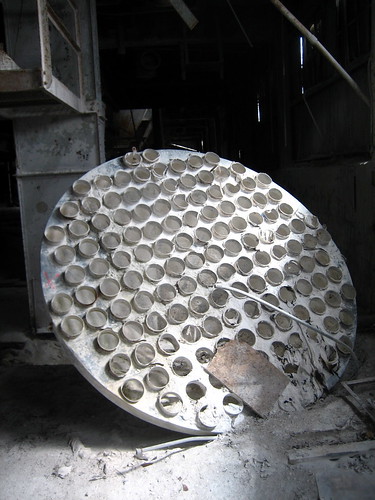I shot two sets of mill photos this weekend. The Carol Cable Factory in Williamstown was still making extension cords when I was a student at Williams, with three shifts of workers manning the molding machines. We founded Tripod across the street at 191 Water Street, and I remember walking past Carol Cable late at night, listening to machines clank and wondering what the inside of the building looked like.
After we filled 191 Water Street and most of 173 Water, we were looking for more office space in Williamstown. One of our board members looked across the street and said, “Wonder if they’ve got any space to lease?” They did. We took over almost 15,000 square feet, the top floor of the main building. While we wrote software, the folks a floor below put labels on extension cords, and in the basement, people welded containers for low-level radioactive waste.

The north side of 160 Water Street. The uncovered window was my office from 1997-99.
After Lycos bought Tripod, Bo Peabody’s new venture capital firm took over the space. A few years later, General Cable closed the Carol facility and sold the building to a real estate firm in Cambridge, MA. They began tearing down outbuildings and turning the main building into condos. The developer, Bob Kuhn, died of a heart attack in 2006, and development has ceased.
(My set of photos from the Carol Cable mill. The mill on Google maps.)
My friend Hal, who runs the record store across the street from the Carol Cable factory, told me about an abandoned mill about 15 miles south, near my house in Lanesboro. It’s a former lime kiln about 100 meters from a road I’ve driven hundreds of times without noticing the mill. The kiln was founded by the Farnam brothers in 1874 on the banks of Cheshire Lake. According to one account, it was a part of the U.S. Gypsum company until the 1960s, when the facility was closed and abandoned.

Lime is remarkable stuff. It’s made by cooking Calcium Carbonate (found in limestone) at high temperatures, releasing carbon dioxide. Hydrating lime (calcuim oxide) releases heat, making lime plus water an inexpensive way of creating heat without flame. Hydrated lime is a key part of plaster and mortar, which made it a major industrial commodity when the Berkshires were still filled with mills. Specialty Minerals in Adams, about ten miles north, still produces quicklime today.

The Farnam Limeworks on Google Maps. A wider view, showing two lime quarries a mile north. Photos from the Limeworks.

Pingback: …My heart’s in Accra » Where I work these days.
so commenting on a post this old is probably useless, but lime is also really useful in food preparation– specifically, the process of nixtamalization (http://en.wikipedia.org/wiki/Nixtamalization), wherein indigestible corn husks are removed from corn by soaking them in basically low-concentration limewater before the corn is ground into meal. This helps make it easier on the stomach to eat, but also increases the nutritive content (i think mostly calcium-wise) significantly. The process is old in south america, but i’m not sure if it’s spread elsewhere.
anyways, yeah, go lime.
Comments are closed.